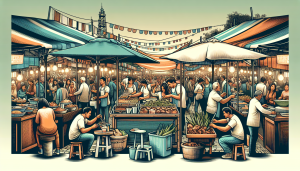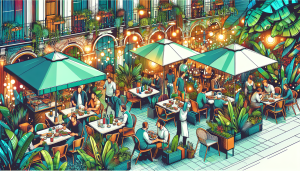
Introduction to Outdoor Dining in Buenos Aires
In the bustling metropolis of Buenos Aires, outdoor dining is more than just a culinary experience; it's a vibrant part of the city's cultural tapestry. To truly appreciate this delightful aspect of Buenos Aires, it's essential to delve into its historical roots and understand its cultural significance. As we embark on this journey, let's explore how outdoor dining has evolved and why it continues to captivate the hearts of locals and visitors alike.
The Historical Roots of Outdoor Dining

The tradition of outdoor dining in Buenos Aires can be traced back to the early 19th century. During this period, Buenos Aires was rapidly transforming into a cosmopolitan hub, attracting immigrants from Europe and beyond. These newcomers brought with them rich culinary traditions, many of which involved communal eating and enjoying meals en plein air.

Cafés and Bodegones

The emergence of cafés and bodegones (traditional Argentine eateries) played a significant role in the development of outdoor dining. Cafés, often inspired by European models, became popular gathering spots where people could enjoy a coffee or a quick bite while engaging in lively conversations. Bodegones, on the other hand, offered hearty meals that showcased the fusion of Argentine and immigrant flavors. Both establishments frequently featured outdoor seating, allowing patrons to relish their food while soaking in the vibrant street life.

| Establishment Type | Key Features | Cultural Impact |
|---|---|---|
| Cafés | Coffee, pastries, social interactions | Promoted a café culture with intellectual and social ties |
| Bodegones | Hearty meals, Argentine-immigrant fusion cuisine | Celebrated communal dining and diverse culinary heritage |

The Influence of European Culture

Buenos Aires' outdoor dining scene has been profoundly influenced by its European roots. The city's architecture, street layout, and culinary habits echo those of European capitals, particularly Paris and Madrid. The tradition of dining al fresco, with tables spilling onto sidewalks, is reminiscent of Parisian boulevards. This influence is not only seen in the ambiance but also in the menus that boast a blend of Argentine flavors and European culinary techniques.

The Role of the Plaza

Public squares, or plazas, have historically served as focal points for community gatherings in Buenos Aires. These open spaces became natural venues for outdoor dining, where food vendors and small eateries set up shop to cater to the bustling crowds. The tradition of enjoying meals in plazas continues to this day, with many locals preferring the lively atmosphere of a plaza over the confines of indoor dining.

Cultural Significance of Outdoor Dining

Outdoor dining is deeply embedded in the social fabric of Buenos Aires. It's a reflection of the city's vibrant street life and its residents' love for social interactions. Buenos Aires is a city that thrives on its social culture, and nowhere is this more evident than in its outdoor dining scene.

Social Connectivity: Outdoor dining provides a platform for social interactions, whether it's a casual coffee with friends or a long dinner with family. The open-air setting encourages conversation and connection, making it a preferred choice for many Porteños (residents of Buenos Aires).
Culinary Exploration: With a plethora of cuisines available, outdoor dining allows residents and tourists to explore the diverse flavors of Buenos Aires. From traditional Argentine parrillas (grill houses) to contemporary fusion restaurants, there's something for everyone.
Celebration of Life: In Buenos Aires, dining is not just about food; it's a celebration of life. The act of sharing a meal outdoors is a joyous expression of community and camaraderie, embodying the city's vivacious spirit.

Current Trends in Outdoor Dining

In recent years, outdoor dining in Buenos Aires has evolved to adapt to modern lifestyles and trends. The rise of pop-up restaurants and food trucks has added a new dimension to the outdoor dining experience. These mobile eateries offer innovative menus and unique dining experiences, often setting up in parks and public spaces.

Moreover, the pandemic has accelerated the growth of outdoor dining as many establishments expanded their al fresco options to ensure social distancing. This shift has led to an increased appreciation for outdoor spaces and has encouraged restaurants to get creative with their setups, incorporating elements like live music and art installations to enhance the dining experience.

Conclusion

The culture of outdoor dining in Buenos Aires is a testament to the city's rich history and dynamic social life. From its European-inspired cafés to its lively plazas, outdoor dining is an integral part of Buenos Aires' identity, offering a window into the city's soul. As we continue to explore this fascinating aspect of Buenos Aires, we will uncover the stories and traditions that make outdoor dining a cherished ritual for its residents. Whether you're a lifelong Porteño or a curious traveler, the allure of outdoor dining in Buenos Aires is an experience that invites everyone to savor the flavors and spirit of this remarkable city.